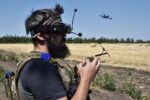At the Association of the United States Army (AUSA) 2025 Annual Meeting in Washington D.C., L3Harris Technologies unveiled a new long-range cruise missile concept tailored for launch from rotary-wing platforms. Designed to extend the standoff strike capabilities of attack helicopters and tiltrotor aircraft, the weapon represents a significant evolution in air-launched precision munitions for contested environments.
A New Strike Option for Rotary-Wing Platforms
The unnamed missile—described by L3Harris as a “helicopter-capable cruise missile”—is designed to be launched from AH-64 Apache helicopters and potentially other vertical takeoff platforms such as the V-280 Valor or MH-60 series. According to company representatives at AUSA 2025, the weapon features a range exceeding 200 kilometers and is intended to provide deep-strike capability without requiring fixed-wing assets.
The design leverages compact folding wings and a low-observable profile to enable carriage on standard helicopter pylons while minimizing radar cross-section. The system is reportedly compatible with standard MIL-STD-1760 interfaces and digital stores management systems used across U.S. Army aviation platforms.
This development aligns with broader U.S. Army modernization goals under Future Vertical Lift (FVL) and Long Range Precision Fires (LRPF), emphasizing survivability and lethality in anti-access/area-denial (A2/AD) environments.
Design Features: Compact Airframe with Strategic Reach
L3Harris displayed a full-scale mockup of the missile at AUSA featuring:
- Folding mid-body wings for compact carriage and aerodynamic stability
- Pop-out tail fins for post-launch control
- A turbojet engine intake mounted ventrally near the rear fuselage
- Estimated length of ~2.4 meters and diameter under 30 cm
The propulsion system is believed to be based on an off-the-shelf small turbojet or turbofan engine similar to those used in loitering munitions or air-launched decoys. This would enable sustained subsonic flight over extended distances while maintaining low radar signature.
Although exact specifications remain undisclosed, sources suggest that the warhead could support multiple payload types including unitary high-explosive (HE), blast-fragmentation, or even electronic warfare modules depending on mission needs.
ISR Integration and Networked Targeting Capabilities
A key feature of the new cruise missile is its integration with airborne ISR assets via networked fire control systems. L3Harris emphasized that targeting data can be relayed from manned or unmanned sensors—including MQ-1C Gray Eagle drones or future FVL reconnaissance aircraft—allowing beyond-line-of-sight engagements without exposing launch platforms to direct threat envelopes.
This approach mirrors concepts seen in Joint All-Domain Command and Control (JADC2) frameworks where sensors and shooters are decoupled across domains. In practice, an Apache could receive coordinates from an overhead drone or satellite feed and launch the missile without visual contact with the target area.
The system is also expected to support GPS/INS navigation with optional terminal seekers such as imaging infrared (IIR) or semi-active laser (SAL) guidance for increased accuracy against mobile targets.
Operational Implications for Army Aviation Doctrine
If fielded successfully, this capability would significantly alter rotary-wing employment doctrine by enabling deep strikes against high-value targets—including command posts, radar sites, air defense nodes—from well outside short-range air defense coverage zones.
This would reduce reliance on fixed-wing strike aircraft like F-35s or F-15Es in early-phase operations where air superiority may not yet be assured. Moreover, it provides maneuver commanders with organic precision fires that can be rapidly retasked based on real-time intelligence updates—a critical advantage in fast-moving multi-domain operations.
The system could also serve as a complementary asset alongside existing munitions such as AGM-179 JAGM (~8 km range) or GMLRS (~70–90 km), filling a gap between tactical missiles and theater-level assets like ATACMS or future Precision Strike Missile (PrSM).
Development Timeline and Acquisition Outlook
L3Harris has not disclosed whether this system is part of an active U.S. Army program of record but confirmed that it was developed using internal research & development funds over the past two years. Company officials stated they are currently in discussions with multiple service branches regarding potential use cases under rapid prototyping authorities such as Other Transaction Agreements (OTAs).
The concept may align with requirements emerging from programs like Long Range Precision Munition (LRPM), which seeks helicopter-compatible missiles capable of engaging targets beyond current Hellfire/JAGM ranges.
If selected for further evaluation by Army Futures Command or PEO Missiles & Space, flight testing could begin within two years depending on funding availability. Given its modular architecture and use of mature subsystems (e.g., propulsion units already flown on other missiles), development timelines may be compressed compared to traditional acquisition cycles.
Comparative Systems: How It Stacks Up
L3Harris’s offering enters a nascent but growing category of long-range rotary-launched cruise missiles—a niche previously explored by international players:
- MBDA Enforcer Air: Lightweight guided munition but lacks strategic reach (~8–10 km)
- Kongsberg’s Joint Strike Missile (JSM): Air-launched stealthy cruise missile (~500 km range), but optimized for fast jets like F-35—not helicopters
- KAI’s TAipers: South Korean helicopter-fired guided rocket still under development; limited range (~20–30 km)
No current Western system offers >200 km standoff capability from rotary-wing platforms in operational service—making this L3Harris concept potentially first-in-class if matured into production.
Conclusion: Toward Distributed Precision Fires from Vertical Lift Assets
The unveiling of L3Harris’s helicopter-capable cruise missile marks an inflection point in expanding deep-strike options for U.S. Army aviation forces operating in contested theaters. By combining extended range with ISR-networked targeting flexibility—and packaging it into a form factor compatible with existing rotorcraft—the system offers commanders new tools for shaping battlespace geometry without exposing high-value platforms to undue risk.
If adopted into formal programs like LRPM or integrated into FVL doctrine sets post-2030, it could redefine how vertical lift assets contribute not just tactically—but strategically—in joint all-domain operations across Indo-Pacific or European theaters alike.










